

Language identification of names with SVMs A D I T Y A B H A R G A V A A N D G R Z E G O R Z K O N D R A K U N I V E R S I T Y O F A L B E R T A N A A C L - H L T 2 0 1 0 J U N E 3 , 2 0 1 0
Outline Introduction: task definition & motivation Previous work: character language models Using SVMs Intrinsic evaluation SVMs outperform language models Applying language identification to machine transliteration Training separate models Conclusion & future work 2/15
Task definition Given a name, what is its language? Same script (no diacritics) Beckham English Brillault French Velazquez Spanish Friesenbichler German 3/15
Motivation Improving letter-to-phoneme performance (Font Llitjós and Black, 2001) Improving machine transliteration performance (Huang, 2005) Adjusting for different semantic transliteration rules between languages (Li et al., 2007) 4/15
Previous approaches Character language models (Cavnar and Trenkle, 1994) Construct models for each language, then choose the language with the most similar model to the test data 99.5% accuracy given >300 characters & 14 languages Given 50 bytes (and 17 languages), language models give only 90.2% (Kruengkrai et al., 2005) Between 13 languages, average F1 on last names is 50% ; full names gives 60% (Konstantopoulos, 2007) Easier with more dissimilar languages: English vs. Chinese vs. Japanese (same script) gives 94.8% (Li et al., 2007) 5/15
Using SVMs Features Substrings (n-grams) of length n for n=1 to 5 Include special characters at the beginning and the end to account for prefixes and suffixes Length of string Kernels Linear, sigmoid, RBF Other kernels (polynomial, string kernels) did not work well 6/15
Evaluation: Transfermarkt corpus European national soccer player names (Konstantopoulos, 2007) from 13 national languages ~15k full names (average length 14.8 characters) ~12k last names (average length 7.8 characters) Noisy data e.g. Dario Dakovic born in Bosnia but plays for Austria, so annotated as German 7/15
Evaluation: Transfermarkt corpus 85 80 75 70 Accuracy Language models 65 Linear SVM 60 RBF SVM 55 Sigmoid SVM 50 45 40 Last names Full names 8/15
Evaluation: Transfermarkt corpus cs da de en es fr it nl no pl pt se yu Recall cs 19 0 15 4 1 3 1 0 0 4 2 1 7 0.33 da 0 27 15 2 0 3 1 1 9 0 0 1 0 0.46 de 4 2 183 12 2 11 2 12 5 10 2 2 9 0.72 en 0 1 20 69 1 12 2 2 1 2 1 0 0 0.62 es 2 0 9 4 25 7 23 0 0 1 9 0 2 0.31 fr 0 0 17 10 5 41 13 1 1 1 4 0 2 0.43 it 1 0 6 2 10 5 84 0 0 2 2 0 1 0.74 nl 1 3 19 9 3 9 1 36 1 2 1 0 0 0.42 no 1 7 9 1 1 3 1 3 17 1 0 2 1 0.36 pl 2 0 13 2 3 3 1 2 1 63 0 0 3 0.68 pt 1 0 4 4 8 7 8 1 0 1 8 0 1 0.19 se 2 0 14 0 1 2 1 2 2 1 1 23 4 0.43 yu 3 0 11 1 2 0 4 1 0 2 0 2 84 0.76 Precision 0.53 0.68 0.55 0.58 0.40 0.39 0.59 0.59 0.46 0.70 0.27 0.74 0.74 9/15
Evaluation: CEJ corpus Chinese, English, and 100 Japanese names (Li et 99 al., 2007) 98 ~97k total names, average 97 length 7.6 characters 96 Language Accuracy Demonstrates a higher models 95 Linear baseline with dissimilar 94 SVM languages 93 Linear SVM only (RBF 92 and sigmoid were slow) 91 90 10/15
Application to machine transliteration Language origin knowledge may help machine transliteration systems pick appropriate rules To test, we manually annotated data English-Hindi transliteration data set from the NEWS 2009 shared task (Li et al., 2009; MSRI, 2009) 454 “Indian” names, 546 “non - Indian” names Average length 7 characters SVM gives 84% language identification accuracy 11/15
Application to machine transliteration Basic idea: use language identification to split data into two language-specific sets Train two separate transliteration models (with less data per model), then combine We use DirecTL (Jiampojamarn et al., 2009) Baseline comparison: random split Three tests: DirecTL (Standard) DirecTL with random split (Random) DirecTL with language identification – informed split (LangID) 12/15
Application to machine transliteration 50 48 46 44 Top-1 accuracy 42 Standard 40 Random LangID 38 36 34 32 30 13/15
Conclusion Language identification of names is difficult SVMs with n-grams as features work better than language models No significant effect on machine transliteration But there does seem to be some useful information 14/15
Future work Web data Other ways of incorporating language information for machine transliteration Direct use as a feature Overlapping (non-disjoint) splits 15/15
Questions?
Recommend
More recommend